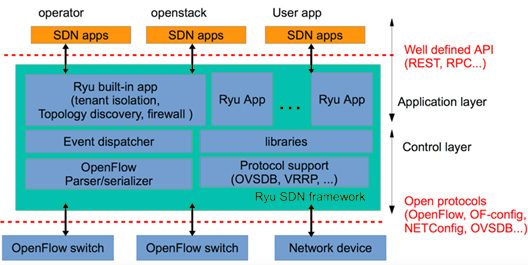
Ryu (pronounced “ree-yooh,” meaning “flow” in Japanese) represents a fundamentally different approach to SDN controllers—rather than a complete platform, it’s a component-based framework that provides building blocks for creating custom SDN solutions. With a score of 73.2% in our comprehensive evaluation, Ryu’s Python-based architecture and well-defined APIs make it the preferred choice for academic research, rapid prototyping, and developers who need complete flexibility to build exactly the SDN controller they envision.
This is part of our comprehensive SDN Controller Comparison Guide, where we evaluate 6 leading open-source controllers across 13 technical criteria.
Ryu at a Glance
| Attribute | Details |
|---|---|
| Overall Score | 73.2% (Ranked #3) |
| Best For | Academic research, custom development, OpenStack integration |
| Architecture | Component-based framework (toolbox approach) |
| Programming Language | Python |
| Primary Protocols | OpenFlow, NETCONF, OF-Config, partial P4 support |
| Clustering | External tools required (Zookeeper) |
| Community | Active development community, popular in academia |
| Key Differentiator | Complete development flexibility with minimal constraints |
| Deployment Complexity | Low to High (depends on customization) |
| License | Apache License 2.0 |
What Ryu Does Best:
- Component-based framework for building custom controllers
- Well-defined Python APIs for rapid development
- Popular in academic research and education
- OpenStack Neutron integration (historical significance)
- Low barrier to entry for Python developers
Understanding Ryu: Framework vs. Platform
The Fundamental Difference:
Ryu is a very different proposition to the other options being put forward. Although boasting a core set of programs that are run as a ‘platform’, Ryu is better thought of as a toolbox, with which SDN controller functionality can be built.
Ryu is a component-based software defined networking framework. It provides software components with well defined API that make it easy for developers to create new network management and control applications. Ryu means “flow” in Japanese and is pronounced “ree-yooh”.
Platform vs. Framework:
| Aspect | Traditional Platform (ONOS/ODL) | Framework (Ryu) |
|---|---|---|
| Out-of-Box | Full-featured controller ready to use | Basic components, build what you need |
| Applications | Pre-built apps included | Write your own applications |
| Clustering | Native HA clustering | DIY with external tools |
| GUI | Production-ready web interface | Basic or build your own |
| Intent Framework | Built-in | Implement if needed |
| Philosophy | “Everything included” | “Minimal core, maximum flexibility” |
| Learning Curve | Learn the platform | Learn the concepts |
| Use Case | Production deployment | Research, custom solutions, prototyping |
What Ryu Provides:
Core Components:
- OpenFlow protocol library (1.0 – 1.5)
- Event-driven application framework
- Network topology discovery
- Basic switching applications (as examples)
- NETCONF/OF-Config libraries
- REST API framework
- Packet parsing libraries
What You Build:
- Custom routing algorithms
- Specific network applications
- High availability mechanisms
- Telemetry and monitoring
- Integration with other systems
- Business logic for your network
The Toolbox Metaphor:
Think of Ryu like a woodworking toolbox:
- Saw (OpenFlow library): Tool to interact with switches
- Hammer (Event framework): Tool to respond to network events
- Measuring tape (Topology discovery): Tool to understand network structure
- Sandpaper (Packet libraries): Tool to process packets
But Ryu doesn’t tell you what to build. You decide whether you’re building a simple birdhouse (learning switch) or a complex cabinet (production router).
Architecture Deep Dive
A Ryu SDN controller composes of these components:

- Southbound interfaces allow communication of SDN switches and controllers
- Its core supports limited applications (e.g. Topology discovery, Learning switch) and libraries
- External applications can deploy network policies to data planes via well-defined northbound APIs such as REST
Modularity and Extensibility
Ryu is structured differently from other solutions in that it provides simple supporting infrastructure that users of the platform must write code to utilise as desired. While this requires development expertise, it also allows complete flexibility of the SDN solution.
Scalability
Ryu does not have an inherent clustering ability and requires external tools to share the network state and allow failover between cluster members.
- External tools such as Zookeeper distribute a desired state. Extra instances of the controller can be started independently as long as the backing configuration remains identical.
Architectural Scalability
- While Ryu supports high availability via a Zookeeper component, it does not yet support a co-operative cluster of controllers.
Interfaces
- Southbound: It supports multiple southbound protocols for managing devices, such as OpenFlow, NETCONF, OF-Config, and partial support of P4
- Northbound: Offer RESTful APIs only, which are limited compared to ONOS and ODL
Telemetry
Ryu doesn’t provide any telemetry functionality. This needs to be provided via external tools.
Resilience and Fault Tolerance
Ryu has no inbuilt clustering mechanism, instead relying on external tools to maintain availability. High availability is achieved by running multiple, identically configured instances, or a single instance controlled by an external framework that detects and restarts failed nodes.
Fault tolerance can be provided by Zookeeper for monitoring the controllers in order to detect controller’s failure and sharding state between cluster members.
Programming Language
Ryu is written in Python.
Community
An active community developing the framework, it is a well supported and targeted controller.







